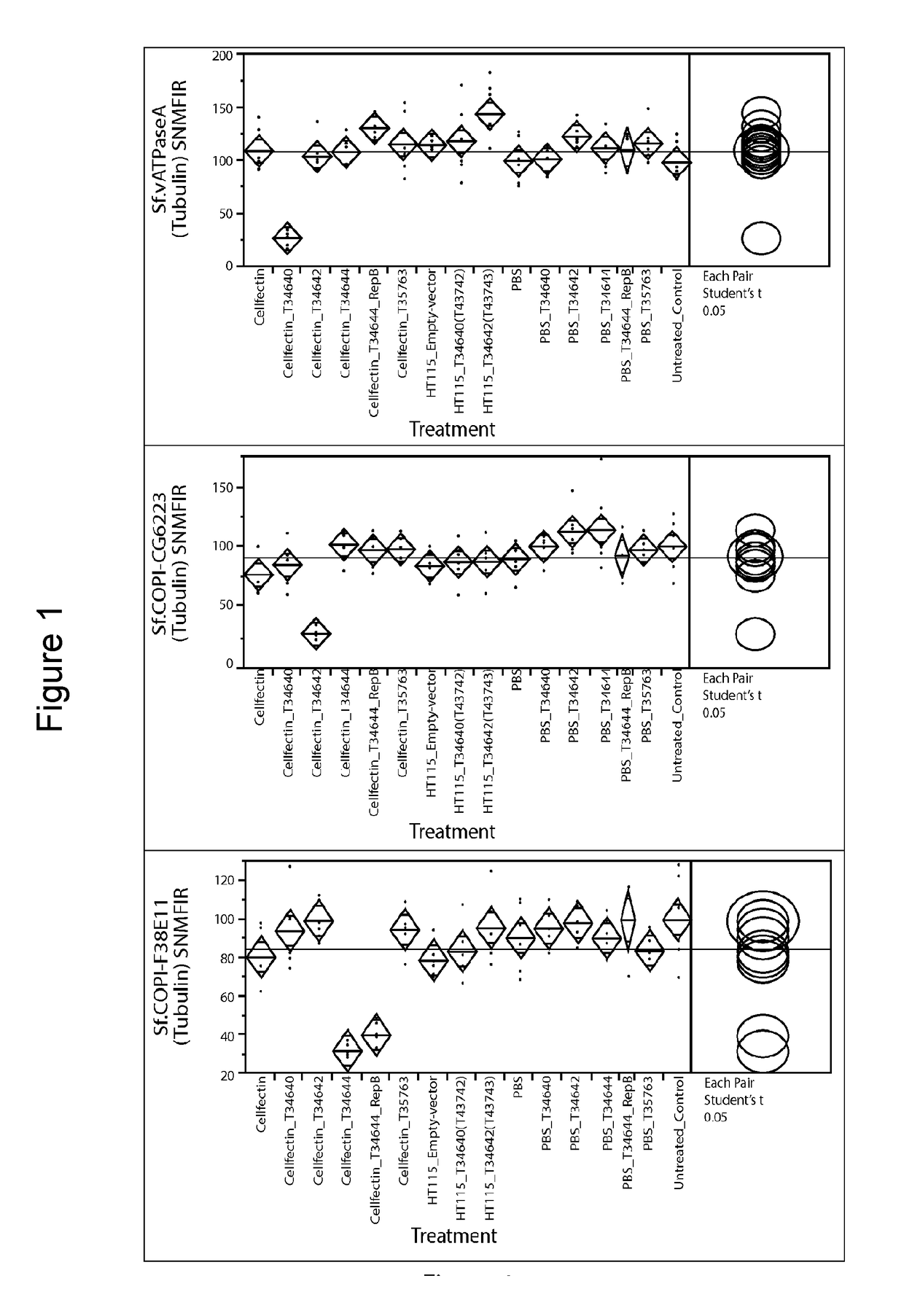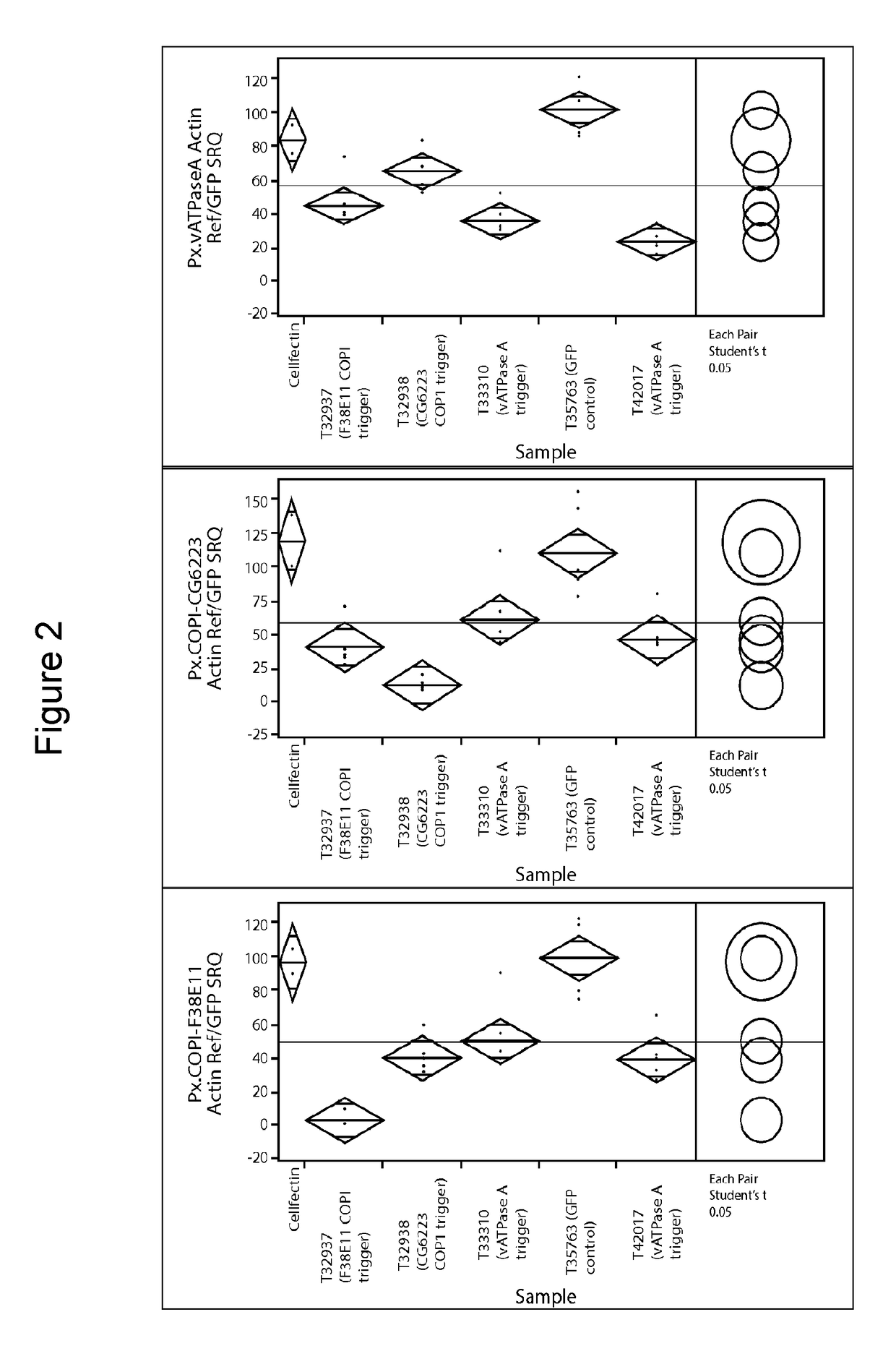Compositions and methods for controlling insect pests
a technology for insect pests and compositions, applied in the field of methods for controlling invertebrate pest infestations, can solve the problems of chemical insecticide use and potential accumulation in the food chain, and achieve the effect of controlling or preventing infestation
- Summary
- Abstract
- Description
- Claims
- Application Information
AI Technical Summary
Benefits of technology
Problems solved by technology
Method used
Image
Examples
example 1
[0115]This example illustrates non-limiting embodiments of coding DNA sequences useful as target genes for controlling insect species and for making compositions and plants of this invention, and identifies dsRNA trigger sequences useful for controlling insect species. Orthologues to genes previously demonstrated to be efficacious targets for RNAi-mediated mortality in western corn rootworm were identified from insect species that have not previously been reported to be susceptible to orally delivered RNA. These orthologous target genes and examples of dsRNA trigger sequences are provided in Table 1.
TABLE 1TargetGeneTriggerSEQ IDTargetTarget Gene Source SpeciesTarget GeneTriggerSEQ IDTriggerNO.Gene ID(common name)AnnotationIDNO.*size (bp)1CG3762Spodoptera frugiperdaV-ATPase subunit AT3464017300(fall armyworm)2F38E11Spodoptera frugiperdaCOPI coatomerT3464419301(fall armyworm)beta prime subunit3CG6223Spodoptera frugiperdaCOPI coatomerT3464218301(fall armyworm)beta subunit4CG3762Lygus ...
example 2
[0117]This example illustrates non-limiting embodiments of dsRNA trigger sequences useful for suppressing or silencing a target gene in an insect cell or causing stunting or mortality in an insect, and methods for validating dsRNA trigger efficacy or for causing stunting or mortality in an insect. More specifically this example illustrates use of dsRNA triggers for sequence-specific reduction of target gene mRNA transcript level in insect cells.
[0118]Cultured Spodoptera frugiperda (fall armyworm, FAW) SF9 cells were incubated with the dsRNA triggers T34640 (SEQ ID NO:17, targetting V-ATPase A subunit), T34642 (SEQ ID NO:18, targetting COPI coatomer B (beta) subunit), or T34644 (SEQ ID NO:19, targetting COPI coatomer B′ (beta prime) subunit), or with a control trigger T35763 (SEQ ID NO:27, a 300 bp dsRNA trigger targetting green fluorescent protein); see Table 1. The dsRNA triggers were formulated with the commercial transfection agent Cellfectin® II (Life Technologies, Inc., Grand I...
example 3
[0120]This example illustrates non-limiting embodiments of dsRNA trigger sequences useful for suppressing or silencing a target gene in an insect cell or causing stunting or mortality in an insect, and methods for validating dsRNA trigger efficacy or for causing stunting or mortality in an insect. More specifically this example illustrates oral delivery of dsRNA triggers for causing stunting or mortality in insects.
[0121]An assay using Euschistus heros (neotropical brown stink bug, NBSB) nymphs fed on an artificial diet was used for testing the efficacy of dsRNA triggers designed specifically to target Euschistus heros genes. Using this assay, a ˜500 base pair dsRNA trigger, T33199, which targets the E. heros ubiquitin C gene, was observed to effect a dose-dependent stunting and mortality response in E. heros nymphs. A shorter (302 bp) dsRNA trigger, T44042 (SEQ ID NO:26) was designed, based on the sequence of T33199, for formulating for oral or topical delivery.
PUM
| Property | Measurement | Unit |
|---|---|---|
| concentration | aaaaa | aaaaa |
| concentration | aaaaa | aaaaa |
| concentration | aaaaa | aaaaa |
Abstract
Description
Claims
Application Information
 Login to View More
Login to View More - R&D
- Intellectual Property
- Life Sciences
- Materials
- Tech Scout
- Unparalleled Data Quality
- Higher Quality Content
- 60% Fewer Hallucinations
Browse by: Latest US Patents, China's latest patents, Technical Efficacy Thesaurus, Application Domain, Technology Topic, Popular Technical Reports.
© 2025 PatSnap. All rights reserved.Legal|Privacy policy|Modern Slavery Act Transparency Statement|Sitemap|About US| Contact US: help@patsnap.com



